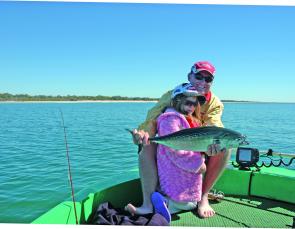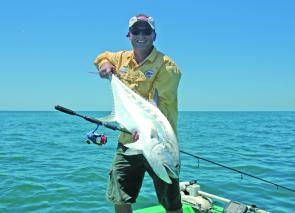Get the woollens out Ma, the brass monkey is shivering.
Yes, we are finally deep into the cooler months and even an ‘imported’ Queenslander like myself gets cold now (after 20 years). July really signifies winter in our parts. The bream will start to run in the Burnett and the snapper will well and truly be biting on most of the inshore reefs. After dark will produce the best inshore results with both the big bream and big snapper as they both prefer the cover of darkness to do their hunting.
The estuaries clean right up at this time of year, and the ever-reliable flathead will be the mainstay for the dedicated creek lure anglers, although in the deeper holes there’s always a few pike and chopper tailor to keep your eye in.
Winter also brings the cold westerlies which mean the first couple of miles of the coast can be pretty calm while further offshore it gets ugly. Fortunately this means my Polycraft will be getting plenty of time chasing the pelagics that patrol not far from shore.
If you have tried chasing tuna unsuccessfully, I have a few fundamentals that may help when you next venture out. Firstly, tuna cruise at around 50km/h and they usually slow down only when they have located a school of baitfish and have rounded them up and pushed them to the surface. At this time you will see them busting through the surface and the baitfish spray in all directions trying to avoid being lunch.
This is the point at which the tuna are most vulnerable to a well-presented metal slice, as they are in ‘pack hunting’ mode. While they are in this feeding mood, the tuna will usually eat anything that resembles the size of the baitfish they are eating, and which is doing what the rest of the baitfish are doing. That is, trying to escape.
Tuna can be very finicky. At times they will refuse all but the smallest of metal slices, if that’s the size of the bait they are hunting. Then there are some days when they aren’t fussy at all and will pretty much eat anything you throw at them. Those days are gold!
Tuna feed into the wind, so position your boat in front of the school and deliver long, wind-assisted casts to the head of the feeding pack. This will put you in the strike zone, and then you can vary your retrieves until you find out what they want on the day.
Most days, letting the slice sink for a couple of seconds and then winding it back as fast as you can will do the trick. Still, the tuna make the rules and some days they will prefer a slice that has been allowed to sink deep into the school and then retrieved in a stop-start fashion. And then there are days when the tuna just want your slice skimming the surface before they will hunt it down and smash it off the surface right in front of you.
You can get some good by-catches on a tuna trip. Trevally, mackerel and queenfish also hunt the bait schools and will respond to the same techniques. They are not as fussy when it comes to the size of the slice you use, and of course the queenfish just can’t resist a popper.
Reads: 1478
A healthy mack tuna. When targeting tuna, vary your retrieves until you find out what they want on the day.

Queenfish will respond to the same techniques that you would use for tuna.




